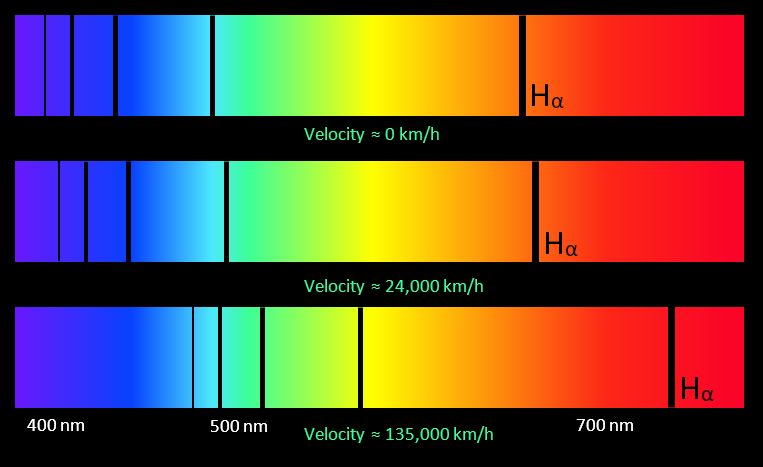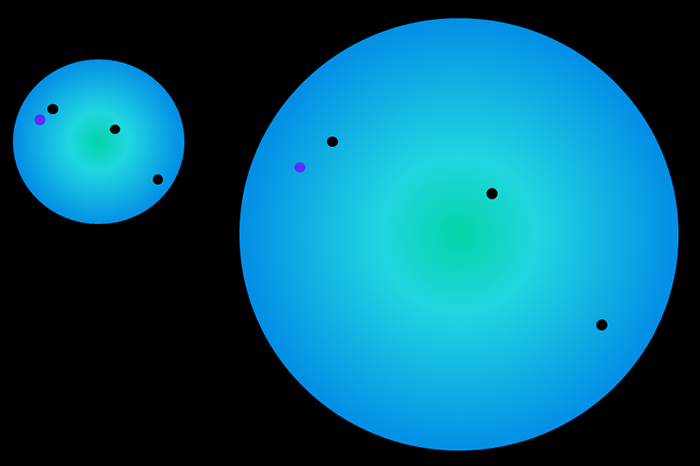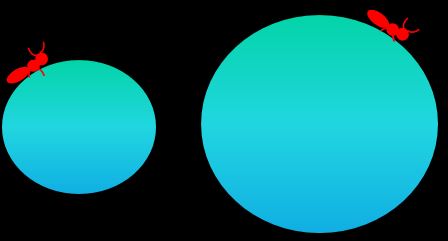
Hubble's law

graphic by K Kadley

Recessional speed = H0 x distance
H0 ≈ 70 km/s /Mpc
© 2005 Pearson Prentice Hall, Inc
Edwin Hubble noticed that while nearby galaxies might be moving toward or away from us, distant galaxies were all redshifted, moving away, and the farthest galaxies were moving the fastest. Plotting the speed of the galaxies against the distance to the galaxies, the graph appears to be linear, with a slope of about 70 km/s/Mpc, using modern methods of calculating the distances. This means a galaxy that is 1 million parsecs away is moving at 70 km/s, a galaxy that is 2 million parsecs away is moving 140 km/s, etc. We call this mathematical relationship "Hubble's law."
Hubble's law: recession speed = H0 x distance

graphic by K Kadley
Why would all of these distant galaxies be moving away? Either we must be in a very special place in the universe, or it must appear like this to other galaxies, wherever they are. The more likely answer is that we are not special, that this is a global effect.
One mechanism that would make it appear to all galaxies that other galaxies were moving away progressively faster, would be that the entire universe was expanding. Any two dots on these spherical surfaces are getting farther apart, and the motion increases as more of the surface area is involved. This effect is only noticed on the large scale, individual objects like rocks, planets and stars are not expanding, they are held together by internal forces.
The redshift caused by the expansion of the universe is called the cosmological redshift, to distinguish it from redshift caused by other kinds of motion.
The realization that the cosmological redshift indicates the expansion of the universe gives rise to another idea. The galaxies must have been closer together in the past. Running the sequence backward in time would result in an early time when all matter and energy in the universe was very close together and very dense. The recognition of the expansion of the universe brought about the theory of the Big Bang.
Look-back time

time 1
time 2
how far did the ant crawl?
graphic by K Kadley
Light takes a finite time to travel from one place to another. When we say a star is three light years away, we mean that it took light three years to travel from the star to us. The light that we are seeing left the star three years ago. We don't know what is happening on the star right now.
The farther away a star is, the farther back in time we are seeing it.
Now, when we are talking about very distant galaxies, there is more to consider. While the light was traveling, the universe was expanding. The very space that the light traveled through got bigger, stretching out the light, making the wavelength longer.
If you view a distant galaxy, you are seeing the light that left it a very long time ago. If you ask, "How far away is the galaxy?" the question becomes vague. Do you mean how far away was it when the light left it? Even that is hard to say. In the diagram above, an ant crawl on an expanding sphere. Do you measure the distance it crawled by how many steps it took, or how far its ending point is from its starting point? This is why cosmologists prefer to talk about redshift or look-back time as opposed to distance, they are much more clearly defined. Look-back time is just how long ago the light was emitted from the object.
Recall that if a light source was moving away from us, the spectrum would be redshifted. For an absorption spectrum, this means that a hydrogen alpha line, for example, would appear at a longer wavelength against a continuous spectrum. This effect is due to the Doppler shift of a light source with a relative velocity with respect to an observer.